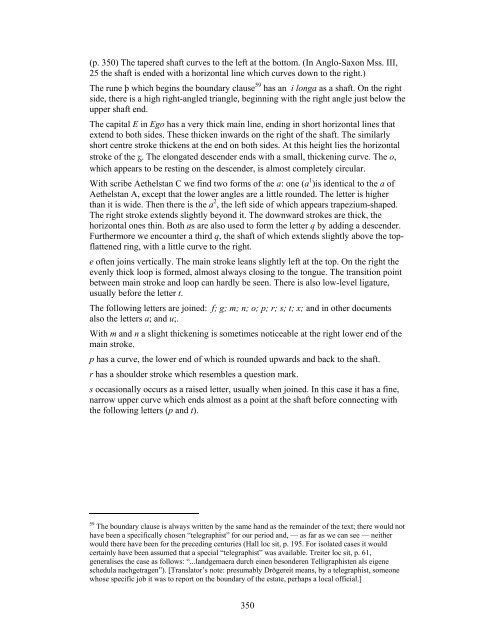Provisional Drogereit pdf
Provisional Drogereit pdf
Provisional Drogereit pdf
You also want an ePaper? Increase the reach of your titles
YUMPU automatically turns print PDFs into web optimized ePapers that Google loves.
(p. 350) The tapered shaft curves to the left at the bottom. (In Anglo-Saxon Mss. III,<br />
25 the shaft is ended with a horizontal line which curves down to the right.)<br />
The rune þ which begins the boundary clause 59 has an i longa as a shaft. On the right<br />
side, there is a high right-angled triangle, beginning with the right angle just below the<br />
upper shaft end.<br />
The capital E in Ego has a very thick main line, ending in short horizontal lines that<br />
extend to both sides. These thicken inwards on the right of the shaft. The similarly<br />
short centre stroke thickens at the end on both sides. At this height lies the horizontal<br />
stroke of the . The elongated descender ends with a small, thickening curve. The o,<br />
which appears to be resting on the descender, is almost completely circular.<br />
With scribe Aethelstan C we find two forms of the a: one (a 1 )is identical to the a of<br />
Aethelstan A, except that the lower angles are a little rounded. The letter is higher<br />
than it is wide. Then there is the a 2 , the left side of which appears trapezium-shaped.<br />
The right stroke extends slightly beyond it. The downward strokes are thick, the<br />
horizontal ones thin. Both as are also used to form the letter q by adding a descender.<br />
Furthermore we encounter a third q, the shaft of which extends slightly above the topflattened<br />
ring, with a little curve to the right.<br />
e often joins vertically. The main stroke leans slightly left at the top. On the right the<br />
evenly thick loop is formed, almost always closing to the tongue. The transition point<br />
between main stroke and loop can hardly be seen. There is also low-level ligature,<br />
usually before the letter t.<br />
The following letters are joined: f; g; m; n; o; p; r; s; t; x; and in other documents<br />
also the letters a; and u;.<br />
With m and n a slight thickening is sometimes noticeable at the right lower end of the<br />
main stroke.<br />
p has a curve, the lower end of which is rounded upwards and back to the shaft.<br />
r has a shoulder stroke which resembles a question mark.<br />
s occasionally occurs as a raised letter, usually when joined. In this case it has a fine,<br />
narrow upper curve which ends almost as a point at the shaft before connecting with<br />
the following letters (p and t).<br />
59 The boundary clause is always written by the same hand as the remainder of the text; there would not<br />
have been a specifically chosen “telegraphist” for our period and, — as far as we can see — neither<br />
would there have been for the preceding centuries (Hall loc sit, p. 195. For isolated cases it would<br />
certainly have been assumed that a special “telegraphist” was available. Treiter loc sit, p. 61,<br />
generalises the case as follows: “...landgemaera durch einen besonderen Telligraphisten als eigene<br />
schedula nachgetragen”). [Translator’s note: presumably Drögereit means, by a telegraphist, someone<br />
whose specific job it was to report on the boundary of the estate, perhaps a local official.]<br />
350
















